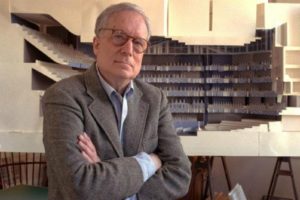By Rick Lightburn, Class of 2008

Robert Venturi’s death in the third week of September gives an occasion to think about him. The distinguished architect won the Pritzker Prize in 1991 and the AIA Gold Medal (with his frequent collaborator Denise Scott Brown) in 2016. Since he designed no structures in Chicago, CAC docents know about him because of his quote “Less is a bore,” which is often understood as a post-modern response, and mostly a rebuke, to Mies’s “Less is more.” Let’s take a minute to consider what Venturi meant by that.
“Less is a bore” appears in Venturi’s 1966 Complexity and Contradiction in Architecture, which is considered the foundational manifesto for Post-Modernism. Docents may be familiar with several famous buildings in a so-called Post-Modern style: Stanley Tigerman’s Anti-Cruelty Society building on North Lasalle, the Harold Washington Library Center on South State Street by Tom Beeby, and Phillip Johnson’s 190 South Lasalle, among many others. But the history of the term “post modernism” shows that actually it had multiple applications, of which some were in sharp and nearly violent contrast with others. The post-modernism of Johnson, Beeby, or Tigerman is very different from that of Venturi, with some different foundational ideas and goals. They all rejected Mies’ minimalism, however, which might be the idea underlying “Less is more.”
The phrase “Less is a bore” in Complexity and Contradiction in Architecture appears in the context of how architects solve problems. Mies’s minimalism led him to finding minimal solutions. Simple problems can have simple solutions. But most of the challenges that architects (and the rest of us) face are complex, or at least appear to be so. Venturi claims that the program for a contemporary residence is inherently full of complexities and contradictions. Minimalism cannot work: Venturi claims: “Where simplicity cannot work, simpleness results. Blatant simplification means bland architecture. Less is a bore.”
Immediately after writing “Less is a bore,” he writes “The recognition of complexity is architecture does not negate … [any] desire for simplicity.” Aesthetic simplicity which satisfies the mind derives from an inner complexity. Nor does complexity deny the importance of looking for simplicity in the analysis of a client’s program, but this method of analysis, he claims, should not be mistaken for a goal.
When I first heard Venturi’s inversion of Mies’s aphorism, I took it to be in an abrasive, in-your-face spirit (as are many examples of Post-Modernism.) That is not the spirit in which Venturi writes. The first chapter of Complexity and Contradiction in Architecture is subtitled “A Gentle Manifesto.”


Rick, Thanks for a new look at someone I, for one, know/knew little about. I appreciated your explanation of the Less is a Bore comment, as I have often thought it explained some of the motivations behind post-Modernism But this gives it a new and deeper meaning. Again, thanks. Ellen.